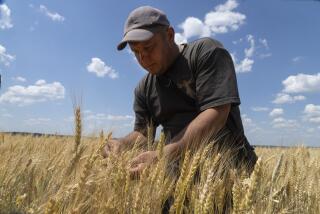Bumper Crops of Grain, Debt : Farmers Continue to Plant in Face of World Surplus
BLOOMINGTON, Ill. — Under bright spring sunshine, in an omnipresent breeze, farmers across the Midwest are hard at work now, planting corn and soybeans in the face of a global glut of grain.
“That’s the only thing we know how to do,” said Bob Reimer, who tills 370 acres here in central Illinois. “We plant, grow and harvest--and it’s more frustrating than it’s ever been.”
The frustration is understandable. There is already enough corn in storage to meet half of the world demand this year, and almost 40% of the soybeans that will be needed. When the worldwide harvest of wheat is completed next summer, the surplus for the year may equal 86% of needs.
Because of this burdensome oversupply, grain prices around the world are depressed and governments are forced to pay tens of billions of dollars in subsidies.
“Our grain elevators are half full now, and usually we are only 20% to 25% full this time of year,” said Fred Gent, who manages the storage facility in nearby Yuton. “This fall, if we have a good crop, we’ll probably have room for only 65% of the harvest.”
“There’s nothing to indicate a decrease in the global glut situation,” said Dennis T. Avery, a senior agricultural analyst with the State Department. “The world has never been as well fed. Most of the public still believes there’s a huge reservoir of hungry mouths out there. There isn’t.”
“Sometimes you feel the seed is better off in the bag than in the ground,” said John L. Olson, whose 1,500-acre grain farm is in McLean, Ill.
The grain surplus is one reason that much of America’s rural economy remains depressed. The second reason is farm debt. Neil E. Harl, an Iowa State University economist, estimates that at least 10% of the nation’s 2.2 million farmers are still in “deep, deep difficulty,” and that perhaps one in four farmers is struggling with debt that is burdensome.
The twin problems of massive overproduction and debt are likely to help prolong the rural depression, which, since 1981, has forced hundreds of thousands of farmers to quit the business, hundreds of small-town businesses to close and scores of financial institutions to fail (59 rural banks in the last year alone). On the average, 165 farms failed every day last year.
As the planting season begins, one thing appears certain: the only way most grain farmers will make a profit this year is through the government aid spelled out in the 1985 farm bill. To get that aid, farmers will have to leave as much as 35% of their lands fallow, in a program designed to reduce American surpluses. Farm subsidies this year may cost the federal Treasury a record $28 billion, up from $25.3 billion last year.
Costly Farm Aid
Agriculture Department figures for 1986 show that nearly 56% of the gross receipts of corn farms and 50% of the gross receipts of wheat producers came from subsidies, and economists predict that this year’s payments will be as large.
“We’re paying for a substantial portion of the cost of production of grain out of the federal Treasury,” said Barry L. Flinchbaugh, a Kansas State University agricultural economist.
“If it wasn’t for the tremendous flow of government payments, it would be shambles out there,” said Robert G. F. Spitze, University of Illinois agricultural economist.
Massive government aid is helping to slow the rural depression, as indebted farmers use those payments to reduce their bank loans and debt-free farmers use their surplus to buy the lands and assets of failing farms, Iowa State’s Harl said.
There is a move in Congress to rewrite the 1985 farm legislation to improve federal controls on production and to increase farm aid. Proponents of the changes, including some labor organizations and some farm groups, say that the current program has not boosted U.S. agricultural exports and encourages overproduction.
Pressure for Bail-Out
There is also pressure on the Congress to bail out the quasi-federal Farm Credit System, the nation’s largest agricultural lender. A report issued last week in Washington said the system may have operating losses of as much as $11.7 billion by 1994.
The Farm Credit System is a network of more than 400 farm-owned banks. The American Farm Bureau said earlier last week that the system urgently needs at least $3 billion in federal aid, and a federal bail-out of the system would sharply increase the cost of farm aid this year.
Amid the continuing problems of American agriculture, there is the perennial spring crop of optimism among farmers--bolstered by cautious projections from economists--that the long farm depression may begin to moderate this year.
New Uses Anticipated
“Sooner or later, things will turn around, if we can just weather these rough times until we find more uses for corn or regain our export markets,” said Jim Rafferty, who works 1,100 acres with his father in LeRoy, a central Illinois community.
“With a lot of hard work, research and market development, ag could be back on its feet in the very near future,” said farmer John L. Olson.
“We don’t see any quick fixes,” said agricultural economist Abner W. Womack, “but we do see a very slow turnaround for U.S. agriculture.”
“I see very slight improvement,” said Flinchbaugh, the Kansas State economist. “There are many positive signs out there on the horizon, but the road to turnaround is going to be extremely long.”
Those positive signs include a moderation of interest rates, a slowing of the decline of farmland values, cheaper fuel and power and continued, generous federal farm aid.
An overall solution is elusive, however.
Farmers here acknowledge that there is too much corn in the world, but, rather than looking to foreign buyers as they did a decade ago, they now are pinning their hopes for the future on new uses for their grain.
Among them is a corn-based road de-icer that would replace the corrosive salt now used throughout the Midwest and the Northeast. Farmers are also encouraged by work on a corn-based, biodegradable plastic.
Corn-Based Fuels
“Our biggest hope is for more reliance on corn to replace fossil fuels,” said farmer Olson. “You can’t burn petroleum forever and not expect to run out. There’s hope for renewable resources,” he said, noting that corn is a major source of ethanol, a petroleum substitute.
For the moment, however, such prospects seem more hopeful than realistic.
Economists and analysts, from the State Department’s Avery to the University of Illinois’ Spitze to Iowa’s Harl, agree that the world glut will continue to depress American grain prices and continued federal subsidies will be needed.
“The world is committing too many resources to food production, given the present demand for food,” Harl said.
Researcher Wendy Leopold in Chicago contributed to this story.
More to Read
Sign up for Essential California
The most important California stories and recommendations in your inbox every morning.
You may occasionally receive promotional content from the Los Angeles Times.










